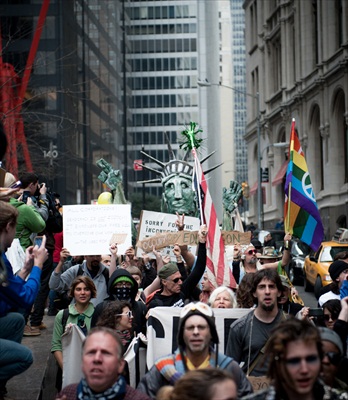
Occupy Wall Street Protestors begin a procession toward the Wall Street bull on Saturday, March 17, 2012. The Occupy Wall Street Movement marked six months with a march on Wall Street followed by a gathering at Manhattan's Zuccotti Park, where the movement started. Throughout the course of the movement, many photos have been taken of OWS protestors, but very few have any names attached to them. Photo by Wasim Ahmad.
While decisions about what photographs to run are up to editors, what are the responsibilities of the photojournalist to name the subjects of photographs in captions? Captions can go a long way towards humanizing a subject. The act of simply attaching a name to a face reveals a bit of the story that a simple photograph can’t.
So why, then, are most Occupy Wall Street protestors pictured in many photos from large media outlets nameless figures? When did it become OK to submit a photo for publication and not include names? A generic caption with the identified “an Occupy Wall Street protestor,” instead of an actual name, does not leave the reader with a connection to the subject. It makes the photographed “the other.”
The problem isn’t limited to just Occupy Wall Street coverage (Last year, iMediaEthics tracked down an unnamed man pictured in much of the 2007 reporting on Benazir Bhutto’s assassination), but I’ve noticed a pattern of nameless captions in wire services photos as I’ve covered the story alongside my students at Stony Brook University.
So I asked editors at the Associated Press and other photographers — what’s in a name?

Two examples (of many) from AP Images of photos that have a dominant subject, but no names in a caption. On the left, it’s odd that the photographer would clearly make enough of a connection to make this intimate image, but then only label the person a “participant.” On the right, the woman with blue hair is a prominent figure in the movement, having been featured in several news stories. But you wouldn’t know it since her name – Lauren DiGioia – isn’t anywhere in the caption. You can read some of the stories here and here.
Photojournalists have to approach subjects with 10 pounds of gear in tow unlike writers with a pen and notebook. A long telephoto lens and a brick-like camera body are intimidating. There are extra amounts of conversation and effort involved just to get a source comfortable with talking, never mind giving the photojournalist a name.
A photographer is a casual observer of events. He or she records a scene with a camera. A photojournalist, in contrast, records the scene with a camera, then gets the story behind it. That’s why a caption is so important.
My young charges often don’t realize that photojournalists have a duty to the “journalist” part of their title. Being a photojournalist includes telling people’s stories — actually talking to them — in addition to taking pictures.
A common misconception amongst students entering photojournalism programs I have found is that they think that it doesn’t involve talking to anyone.
The Importance of Captions

New York-based photographer Victoria Schultz photographs a flag-wielding Rit Picone, of New Paltz, N.Y. on Saturday, March 17, 2012, for a series of portraits she was making of Occupy Wall Street demonstrators at Manhattan’s Zuccotti Park. Schultz’s large format film camera is even more intimidating compared to a digital setup of the average photojournalist, yet folks consistently posed for her portrait series and gave them their names. Oddly, though I watched her gather names, she doesn’t place any on her website (here). Photo by Wasim Ahmad.
The Occupy Wall Street movement has proven to be fertile ground for reporting projects for many of my Web journalism students at Stony Brook University.
But too often, students (and seasoned journalists) have treated Occupy Wall Street like it’s a zoo. Go down to New York’s Zuccotti Park (or many other places in the city these days), interview the strangest-looking people about why they are there, string a few quotes together, take a few photos, and that’s it. Sources photographed more often than not do not even have names in photo captions. It makes the process so impersonal and gives subjects the short shift.

Elena Strujan, who said she is originally from Romania but has been living in New York for 17 years, protests at Occupy Wall Street at Manhattan’s Zuccotti Park on Sunday, Oct. 23, 2011. She said a failed carbon monoxide detector put her in the hospital, and the resulting medical bills and court cases have caused her financial hardship. Many types of people protest at Occupy Wall Street, but most don’t go to these extremes in their wardrobe choices. That also means that these few people – the ones with the more elaborate outfits – make the news photos more than the “average”-looking protestors. Photo by Wasim Ahmad.
Such surface-level reporting may suffice at the beginning of a story, but ten months later, it’s pathetic. Interviewing only the fringe elements of a group is not a sustainable way to report any story, especially Occupy Wall Street. What’s the complete story and depiction of the ongoing event?
I asked that of many of my students who came back from Occupy Wall Street with photos of people without names, without real depth to their photos beyond subjects with interesting wardrobes.
Many students responded that Occupiers wouldn’t share their names or were afraid to be identified for fear of reprisal — odd, considering they were in a public park with the eyes of the world on them. Essentially, students came back empty-handed.
I tested those assertions. Shortly after the Occupy movement started in September 2011. I saw the tent city. And, as I photographed dozens of protestors over the course of four hours, I talked to them — some of whom my students had even photographed. Only one wouldn’t give me a name. Everyone was willing to talk to me.
Working Occupy Wall Street
Six months after the movement started, on March 17, nine students and I made a return visit to Zuccotti Park. We were there from the beginning of the day’s events around noon, until their batteries ran out and their memory cards filled up.
My students came back with some great photos.
But many of the photos had nameless captions, even of fairly prominent figures in the movement.
With all of the time spent at Zuccotti Park, the protestors in their photos weren’t always shouting at police, banging on drums or otherwise engaged in some kind of action. Indeed, hours of inaction was more the norm for that day, as well as most other days. Plenty of time to talk to people – and get their names.
In many cases – whether it was the professionals or the students – I talked to the same people who showed up in the photos, and managed to get their names. If I wasn’t able to find them that day, or I happened upon a photo later in editing that I realized was better than expected, I was able to get a name on a return visit to the park or by scouring previous Occupy Wall Street coverage on the Web.
It’s easier than one would think to get someone to give you a name.

In this photo taken by a Stony Brook University student, Ethan Freedman, Lauren DiGioia, with the blue hair on the right, is one of Occupy Wall Street’s icons. Here, on the six-month anniversary of the beginning of the movement on March 17, 2012, she was wrestled to the ground by three officers in Zuccotti Park after she was dancing on the sidewalk. The photo captures the decisive moment. The problem is, Freedman wasn’t able to get a name because of the chaos of the scene. That’s fine, but then it’s time to do research to give the photo the impact it deserves – Google searching for a blue-haired woman amongst previous Occupy Wall Street coverage turns her name and ID up very quickly – and it was something I confirmed when I went back the next week to find her in her usual spot (Union Square) with the protestors. Photo courtesy of Ethan Freedman.
Photojournalists Agree: Naming Subjects is Important
Photojournalist Andrew Burton agreed that it’s a problem, but noted that this failure is not just limited to student journalists.
“A lot of photographers are embarrassed to confront people,” Burton, a photographer who was covered Occupy Wall Street regularly as a freelancer for Getty images and other news organizations, told me by phone. “The photographer assumes the subject doesn’t want their photo to be taken, but overcomes that and takes the photo anyway.”
This is usually followed by approaching the subject and getting a name, but Burton admitted it’s not easy in all circumstances.
“I’m not as good at getting names at parades – they are really raucous events with big crowd and lots of photos,” Burton said.

Andrew Burton, a freelance photographer who has shot Occupy Wall Street for Getty Images, tries to get a name whenever he can, but isn’t always successful. In these two cases above, seen on Getty Images, it’s hard to derive extra context about what’s happening without names or quotes from the people in the photos. I’m told, in the case of the second photo, by the caption that these subjects are crying, but I’m not sure why – They’ve come from a march to protest over the killing of Trayvon Martin, but readers don’t know if they’re relatives, friends, or just concerned onlookers.
A search of Burton’s work from Occupy Wall Street in Getty Images’ archives reveals that he apparently is often unable to get a name in the chaos of the moment – something he suggests is difficult under the deadline pressure that wire service photographers are put under.
It’s an odd dichotomy in his body of work – there are some deep profiles of particular facets of Occupy Wall Street, and some intimate portraits of individual protestors. He’s clearly spent some long nights covering the story and has taken the time to get below the surface. It is, perhaps, a reflection of the amount of time a photographer is willing to put into the story – Burton said he wanted to see past the attention-grabbing protests and figure out what the protestors do when they go home at night.
It is, perhaps, a reflection of the demands on a wire service photographer’s time. Or is it?
Another freelance photographer, John Minchillo, who strings for the Associated Press, told iMediaEthics by email that sometimes there are legitimate reasons for not getting subjects’ names. “There are times, however, when gathering a name can result in missing an important shot, interfere with or disrupt a scene egregiously, or put myself in danger,” he said.
It’s an interesting argument from Minchillo because he was there the same March day I was with my group of students, taking photos of the same people we were. But, his photos from that day didn’t have names in the captions.
One of my students made a point to pull up Minchillo’s photos a few days later and ask why I required names while the Associated Press obviously didn’t.. I asked Minchillo, who cited both his own approach and what he said AP editors wanted from him.

John Minchillo, who was working for the Associated Press that day, took these photos from the sixth anniversary of Occupy Wall Street. In these captions, seen on AP Images, There are several clear subjects that should be named, but with the exception of the New York City Councilman, Ydanis Rodriguez, none are. Who are these people? What are they so clearly impassioned about? Why isn’t it important to get their names? Both of them spent significant amounts of time in the park that day outside of these moments. I ran into the man on the right, Hairo Gonzalez, of New York, in July. He’s a trustee of Occupy Marines – a group affiliated with Occupy Wall Street. He said that no one ever came up to him to ask him his name for a photo, including this one.
“My default methodology is that if the situation permits me to gather a name, I will pursue it vigorously, under all reasonable circumstances, regardless of who I’m shooting for. Although I have never seen it written, I believe this is what the AP expects,” Minchillo wrote.
“There are times when circumstances result in not gathering the name. This does not invalidate the photograph, or suggest that it lacks news value. Content is still king, and if the image portrays the scene accurately and informatively, I will not omit it from the take,” he continued.
There are captioning guidelines in the AP Style Guide, Santiago Lyon, Vice President and Director of Photography for the Associated Press, told iMediaEthics by phone. But, in the guide, aside from mentioning where names go in a caption, there’s no strong recommendation or requirement that names be there.
The guidelines state:
“Names should always be listed in order, left to right, unless it is impossible for the caption to read normally otherwise. With multiple people identified within the caption, enough representations to placement are necessary that there is no confusion for who is who.”
It’s not a very forceful guideline. It echoes the point that Minchillo made and that Lyon clarified — names aren’t as important as the image.
“The absence of a name wouldn’t preclude them [AP’s customers] from using the picture because there’s probably a lot of other contextual information,” Lyon said, noting that most photos have stories that run alongside them on the Web or in print.
But does that make it right? Especially in cases where it’s so easy to obtain names?
Looking at one of the photos my students brought up (see here), it’s pretty clear who the subject of the photo is, yet he’s not named.

A direct comparison – John Minchillo and I happened to photograph the same person that day, March 17. In both photos (Minchillo’s is on the left, mine is on the right) Scout Thomas, of New York, was a little busy -perhaps too much to give a name. But the other 8+ hours he remained (including directly before and after the march he’s participating in for Minchillo’s shot) he was mostly standing around Zuccotti Park. He freely gave me a name. I asked Minchillo, who was also standing around the park most of the day taking photos, specifically why there was no name in his photo, but he didn’t respond to my repeated e-mails.
Minchillo and I had photographed the same man, but Minchillo’s photographs didn’t name him. On the other hand, the photo’s subject, Scout Thomas of New York City, had been in the park all day, long before and after the march, and I had spoken with him several times throughout the day. I asked Minchillo how “vigorously” he pursued a name — but I haven’t found out because he never returned my two follow up e-mails.
I also asked him about the circumstances when he was photographing – whether he felt he was in danger or whether he would disrupt the occupation of the park by asking for a name after the march. Looking at many of his photos from Occupy Wall Street, a pattern emerges – unless someone is a famous person or politician, photographers generally don’t get names in his captions – even if they are the only one in the photo. (You can see most of Minchillo’s Occupy Wall Street work on AP Images here.)
If this was a deadline issue – for instance, if Minchillo needed to transmit the photos right after the march – there’s at least some excuse here. But the “submit date” for Minchillo’s photograph on AP’s Images website shows that the picture was turned in about 12 hours after the event, at 3 a.m. on March 18. (The creation date in this case, is before the event actually happened – most likely because of an error in the photographer’s camera settings, Lyon said). [See iMediaEthics’ report on AP photo date errors.]
We asked the AP’s Lyon why a freelancer’s photos might not have complete captions. Lyon, who said Minchillo is a relatively new freelancer for the AP, said:
“It’s a case where the photographer may not have understood the importance of getting a name.”
Minchillo’s first photo on AP images appears to be from May 2011. The photo, of a man walking from Ground Zero with an American flag, doesn’t have a name or any context as to what the photo is about.
Looking through many of the AP’s photos of Occupy Wall Street and other protests, Minchillo isn’t an exception in failing to provide names for his photographed subjects — in many cases, the dominant subjects in photos just aren’t being named. And that’s a problem, Lyon said.
“It humanizes people if you do get a name, and I think there’s a real value to getting name. And I hope that people would be more diligent about getting names,” Lyon said.

I’ve singled out a few photographers here, but it’s not an individual problem, it’s an industry problem. It’s an education problem. Here’s a couple more – Getty on the left, AP on the right. Looks like Mario Tama happened to photograph a familiar face.
Associated Press: How is this Problem Being Fixed?
According to AP, it’s all in the approach — both in how photographers approach the story and how they approach their subjects.
“A photographer’s work is a direct reflection of photographer’s attitude toward the subject.” Lyon said. “If you are brusque or short with someone and then raise the camera to take a picture, you’ll see that in the photo.”
It’s about building trust to the point where someone is comfortable with the photographer in their presence, and in giving them personal information, Lyon said.
“I think the whole dynamic between the interaction between subject and photographer is important. You have to gain the subject’s trust and confidence, have to elicit information from them willingly,” Lyon said. “It’s a step towards elusive condition that photographers know as invisibility – where they are no longer a distraction in the scene they are photographing.”
Lyon encourages expressing genuine interest in the stories of the people photographers engage with. But when all else fails, there’s another approach.
“I wouldn’t discount telling people honestly that you need their name,” Tom Kent, AP’s Standards Editor told iMediaEhics by phone. “[The subjects] will quite likely comply with a little requirement – if you roll your eyes and say it’s policy.”
Kent said to make sure conflicts of interest are avoided during the rapport-building conversation, however. “As you banter you have to avoid expressing sympathy for their cause,” Kent said.
That said, to even be in that position, the photographer would actually had to have talked to the subject first.
No Names? Not Journalism…
When a student asked me about using his photo for class without naming the subject, I said no – I told him that he didn’t commit the “journalism” part of “photojournalism” and so the photo couldn’t be used.
Lyon agreed that it’s good policy.
“In an ideal world, we’d like to have [a name] every time. Is that possible to have it every time? No.” Lyon said. “I think that’s a big mistake – photography is another branch of journalism – being diligent about information gathering is important. Often those approaches will uncover all sorts of information – some of it may be relevant to wider coverage of the issue.”
End Note : Associated Press says Names in Captions Help Stories Go Local
There’s even a practical reason for getting names – search engine optimization, according to the AP. When people search for a name in Google, chances are, if it’s in a caption, it will come up. The more information in a caption, the larger the potential audience searching for it will be.
The AP’s Lyon told iMediaEthics by phone that names can help push a photo beyond its coverage area.
“In an ideal world we would have names most of the time or all of the time. We encourage our photographers to be diligent about names and where people are from,” Lyon said. “Regional interest can drive a picture that wouldn’t ordinarily have interest in a region.”
So if someone from St. Cloud, Minn. shows up at an Occupy Wall Street Protest in New York, there’s a new story there for the people of St. Cloud – something they’d never know without a name and identification in a caption.
Wasim Ahmad is an assistant professor at Stony Brook University’s School of Journalism in New York. He has previously worked for newspapers in Minnesota, Florida and upstate New York, and earned a Master of Science in photography from Syracuse University. Ahmad’s work has been recognized by the Freedom Forum and the Center for Innovation in College Media.





Comments Terms and Conditions